Video of the Week:
Controlling Clover in Your Lawn
Flowers:
Sidedressing Annual Flowers
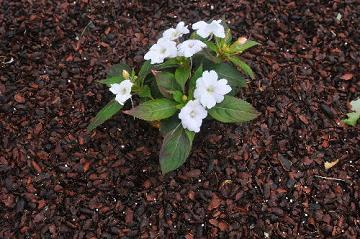
Apply a high nitrogen sidedressing four to six weeks after flowers have been set out. Additional fertilizations every three to four weeks can be helpful during a rainy summer, or if flower beds are irrigated. Common sources of nitrogen-only fertilizers include nitrate of soda, urea, and ammonium sulfate. Blood meal is an organic fertilizer that contains primarily, but not exclusively, nitrogen. Use only one of the listed fertilizers and apply at the rate given below.
Nitrate of soda (16-0-0): Apply 1/3 pound (.75 cup) fertilizer per 100 square feet.
Blood Meal (12-1.5-.6): Apply 7 ounces (7/8 cup) fertilizer per 100 square feet.
Urea (46-0-0): Apply 2 ounces (1/4 cup) fertilizer per 100 square feet.
Ammonium Sulfate (21-0-0): Apply 4 ounces (½ cup) fertilizer per 100 square feet.
If you cannot find the above materials, you can use a lawn fertilizer that is about 30 percent nitrogen (nitrogen is the first number in the set of three) and apply it at the rate of 3 ounces (3/8 cup) per 100 square feet. Do not use a fertilizer that contains a weed killer or weed preventer. (Ward Upham)
Deadheading Flowers
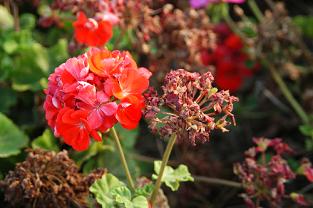
Not all plants need to be deadheaded, including sedum 'Autumn Joy', melampodium, impatiens, most flowering vines, periwinkle (Catharanthus), and wishbone flower (Torenia).
Those that do increase bloom in response to deadheading include hardy geraniums, coreopsis, petunias, marigolds, snapdragons, begonias, roses, campanulas, blanket flowers, delphiniums, zinnias, sweet peas, salvia, scabiosa, annual heliotrope, geraniums (Pelargonium), and yarrow.
Deadheading is easily accomplished by removing spent flowers. With some plants, pinching between a thumb and finger can do this, but tough, wiry stems will require a scissors or pruning shears. (Ward Upham)
Pinching Mums
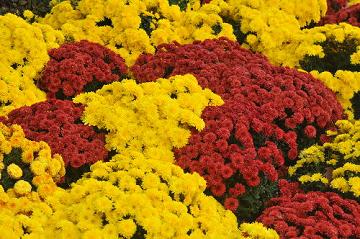
Rust on Hollyhock
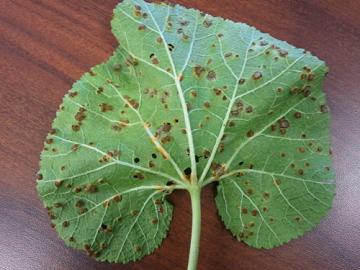
The first line of defense is to remove all hollyhock stalks, leaves and other debris in the fall and destroy them. Remove any infected foliage you see now. Just be sure the foliage is dry so you don’t spread the disease. Continue to remove diseased leaves as soon as they show spots. Try using a fungicide such as sulfur or myclobutanil (Immunox or Immunox Plus) to protect healthy foliage. Note that sulfur may burn leaves if the air temperature is over 85 degrees within 24 hours of application. Follow label directions for timing and rate. (Ward Upham)
Pests:
Iris Borers
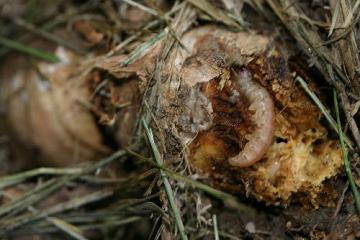
As current-season leaves develop, newly hatched caterpillars/larvae climb up on the new foliage and create tiny pinholes through which they enter leaves. By splitting leaves at those sites, larvae can be found.
By late summer, caterpillars will measure up to 1½ -inches in length and leave the somewhat restricted confines of the leaf. They will bore into the iris rhizomes to complete their feeding phase, after which they leave the rhizome to enter the soil where they will pupate. This will bring us back full circle to the emergence and mating of moths in the fall and the subsequent deposition of overwintering eggs.
The consequences of iris borers are twofold: current-season foliage becomes discolored with tattering along leaf margins, and leaves dying. Also, the bases of the plants as well as their rhizomes become an oozing mushy smelly mess due to fecal contamination along with the action of bacterial soft rot organisms.
At this current point-in-time, plants can be inspected for leaves displaying the presence of iris borer caterpillars. Due to their current small size, they can be squashed by a person running their finger and thumb along the leaf. Or, that leaf may be cut off and disposed of. If larvae are allowed to continue feeding uninterrupted, the entire plant and possibly the rhizome can eventually be roughed out. This would need to be done before pupation in order to prevent the production of new moths/mating/egg production. (Bob Bauernfeind)
Ladybird Beetles
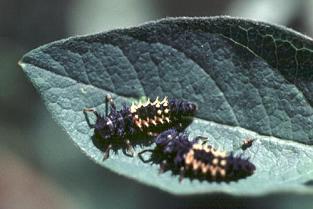
Miscellaneous:
After-Effects of Too Much Rain
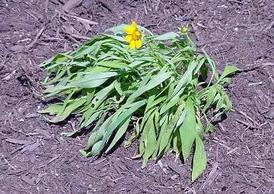
If irrigation is called for, water deeply and infrequently. Usually once per week is sufficient depending on the weather. Soil should be moist but not waterlogged. (Ward Upham)
Contributors: Bob Bauernfeind, Entomologist; Ward Upham, Extension Associate
 RSS Feed
RSS Feed
